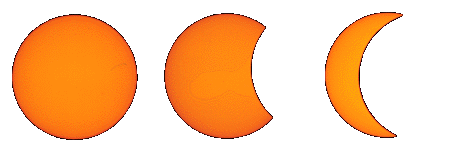|
If you are lucky enough to find yourself inside the path of totality there's lots to see. Let's look at what there is to see on the sun itself. |
|
Our sun has a surface temperature of about 6000 degrees Centigrade. The word "surface" is a bit misleading as the sun is not a solid ball, but rather a gaseous body. If you heat up a gas enough, it becomes ionized (the gas loses outer electrons) and the gas becomes opaque. This opaque and very bright surface of the sun is called the "photosphere." Because the gases of the photosphere are moderately dense, they give off an incandescent white light, like the filament of a lamp. |
|
|
|
Before the eclipse starts - assuming you have the correct and safe viewing apparatus - you will be able to view the entire face of the sun. This is a good chance to see sunspots. Sunspots are slightly cooler areas (about 1500 degrees C cooler) on the sun that look dark compared with the blindingly bright photosphere. If you could move a sunspot off the surface of the sun and look at it all by itself, it would actually be very bright. It's just dark in comparison to the hotter surface of the sun. |
|
Above the photosphere, the gases are cooler. This thin layer, the upper atmosphere of the sun, is called the "chromosphere" because of its colorful nature. Normally you can't see the chromosphere, but the eclipse gives us just the right conditions to observe this beautiful phenomenon. There are always eruptions on the sun which throw huge amounts of glowing gas, often much larger than the earth, high above the sun's surface. These "prominences" are easily seen along the edge of the sun during the total eclipse. The whispy-thin and incredibly hot outer atmosphere of the sun, called the "corona," is also only visible during totality. So now let's get back to the eclipse! |

The moon is up there in the sky too; you just can't see it during the day because the lit side is facing away from us (a phase called "New Moon") and the blue sky washes everything out. As the moon just "touches" the sun (actually coming between, us and the sun, not touching!) you see the first bite taken out of the edge of the sun's disk. This is called "first contact." This is where the partial phases of the eclipse start. For the next
hour and a half the moon will cover more and more
of the sun's disk. As the total phase of the
eclipse approaches, the lighting becomes very
strange. It gets much darker, but unlike at sunset,
the color of the remaining light does not become
orangish and reddish. It just gets grayer. If there
are animals around to observe, the daytime animals
become quiet and prepare for sleep, while at the
same time the nocturnal animals get ready to come
out. This must be a very confusing time for them
because their internal biological clocks must be
telling them it's still daytime! When only a
sliver of the sun is left, with only a few minutes
to go until totality, you might notice long,
straight bands of shadows moving across the ground.
These "shadow bands" form from refraction, or
bending of light in the earth's atmosphere. This is
the same thing that causes stars to twinkle. With
the sun only a long slit of light, the distortions
in the atmosphere become visible as moving bands,
parallel to the remaining slit of sunlight. They
are usually very low in contrast and it helps to
spread a white sheet on the ground to help viewing.
They are VERY difficult to photograph. I've never
seen any pictures of shadow bands. Of course, this
could be because everyone has their cameras trained
on the main event about to happen which is,
admittedly, much more spectacular.
Second contact, when the moon completely covers the sun, happens at about 2:09 PM in Aruba. Now the action really heats up! The edge of the moon is not perfectly round. There are mountains and valleys that make the edge less than smooth. |
||||||||||||||||||||||||||||
 Go Back |
|
What to See During an Eclipse |
||||||||||
|
This resource is presented by The Exploratorium and NASA's Sun-Earth Connection Education Forum. |
The Exploratorium 1998 |

